Rennie Scaysbrook | May 15, 2019
The motorcycle we’ve all been waiting for in 2019 is finally here. The expectations are seriously high for the 2019 Indian FTR 1200 and FTR 1200 S. Read on for in-depth 2019 Indian FTR 1200 and FTR 1200 S reviews.
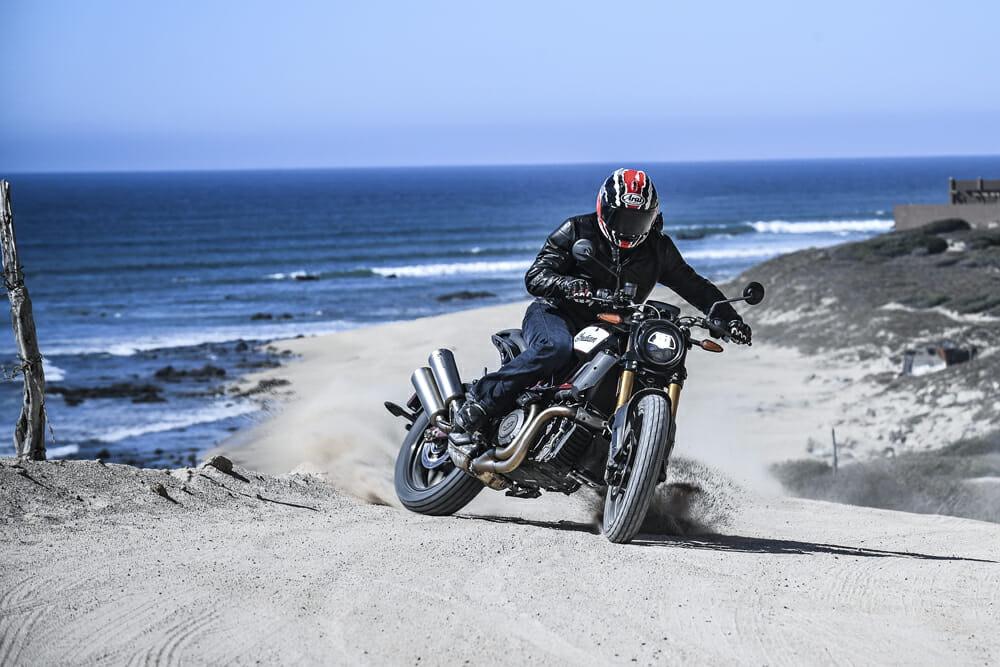 For a bike weighing the best part of 500 lbs., the Indian FTR 1200 is surprisingly fun in the loose stuff.
For a bike weighing the best part of 500 lbs., the Indian FTR 1200 is surprisingly fun in the loose stuff.
It’s nice when a plan comes together. For Indian Motorcycle, that plan was utter annihilation of the American Flat Track Championship with the reborn Indian Wrecking Crew, debuting with a win at Daytona in 2017 and continuing—almost entirely unabated—into the 2019 season.
Two championship wins have followed for the legendary Jared Mees, but this domination was only one part of Indian’s strategic plan. The second was the development and construction of the FTR 1200 and FTR 1200 S, machines based as close as possible to Mees’ 750 but with the necessary concessions to make them a viable option for the street.
Thus, the FTR 1200 is the culmination of four years of development work that ran concurrently to the racebike program, with many thousands of development miles logged between Minneapolis and Switzerland, where Indian’s engine partner SwissAuto are based.
“We started working on FTR 750 in the fall of 2015,” says Indian Senior Director, Reid Wilson. “With the FTR 750, there was a desire to go racing, to live up to the original Indian brand and the records they set in flat track. We saw that we had an opportunity to grow the FTR 750 into a street bike that would be relevant, not only in North America but internationally, and then be competitive on a global stage. So that started basically spring to mid-year of 2016.
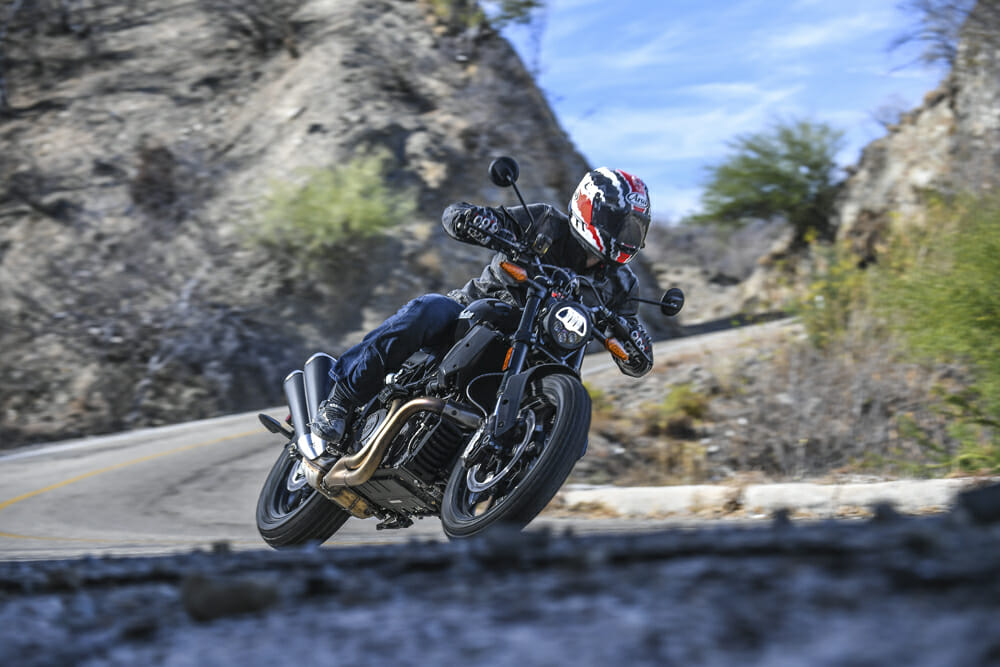 If all you’re doing is road riding, the standard FTR 1200 is an excellent machine with plusher suspension damping.
If all you’re doing is road riding, the standard FTR 1200 is an excellent machine with plusher suspension damping.
“2017 was when we first got on the bike. We stayed in Switzerland because we wanted to design this for a European rider as well as a North American rider, but we really wanted to make sure it meets the needs of the international market. We did a lot of the client testing and development on the roads in the summer in Switzerland. Once we saw the bike, and once we saw the hard model, there were some minor points of discussion, but everybody really loved the design and got behind it. It was actually a pretty seamless development process from a design standpoint.”
The FTR 1200 first broke cover as the FTR 1200 Custom back in the fall of 2017, with the Intermot Show in Cologne, Germany, the scene for the official unveiling of the production machine. From there, it’s been a drip feed of information snippets as various celebrities and social media influencers—who have played a large role in getting the message out for Indian—rode the machine before the official press unveil in Cabo San Lucas, Mexico. Here we spent two days ripping the fruits of Indian’s racing labor around some of the most idyllic coastline imaginable.
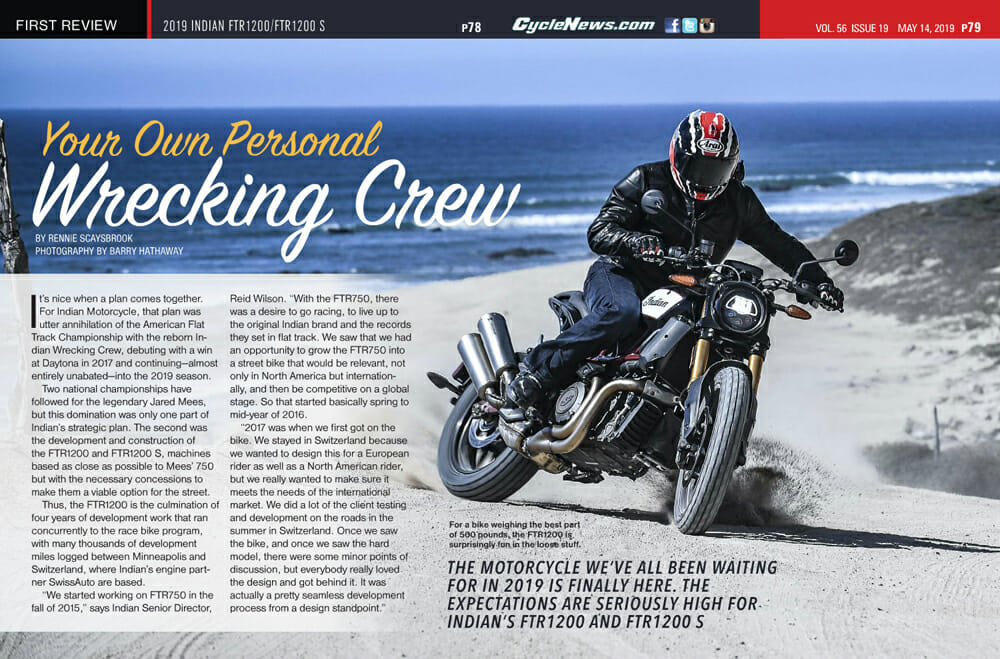
Photography by Barry Hathaway.
Under the skin of the 2019 Indian FTR 1200 and FTR 1200 S
The FTR 1200 comes in two flavors—the base FTR and the up-spec FTR 1200 S. Although both machines share the same motor and basic frame construction, almost everything else is different.
The base model (in one color option, Thunder Black) sells for an MSRP of $13,499, while the S, which comes in three different color options, will cost $15,499 for the Indian Motorcycle Red over Steel Gray, and the Titanium Metallic over Thunder Black Pearl options. The third option, the premium FTR 1200 S Race Replica paint job, will set you back an extra $1500 for an MSRP of $16,999.
Powering both the ride-by-wire 1200 and 1200 S is the all-new 1203cc V-twin, which Indian claims delivers 123 hp and 87 lb-ft of torque with 12.5:1 compression. The engine shares the same architecture as the Scout in that it’s a 60 V-twin, but unlike the Scout Custom released in 2017, this FTR 1200 motor has new cylinder heads, cams, crankshaft, valves, you name it.
Inside the electronics sit three riding modes in Sport and Standard that offer the full 123 hp but with a mellower throttle response in Standard, and Rain mode that reduces output to a claimed 94 hp.
The FTR motor also features magnesium engine covers—a hangover from the FTR 750 race program—as is the intake system, with the airbox placed directly above the motor and the 3.4-gallon gas tank placed under the seat to help in weight distribution and to lower the center of gravity.
The exhausts differ depending on the bike you buy. The base model has brushed stainless-steel mufflers, while the Race Replica FTR 1200 S comes with an Akrapovic titanium twin muffler set-up, which has a much louder bark to it.
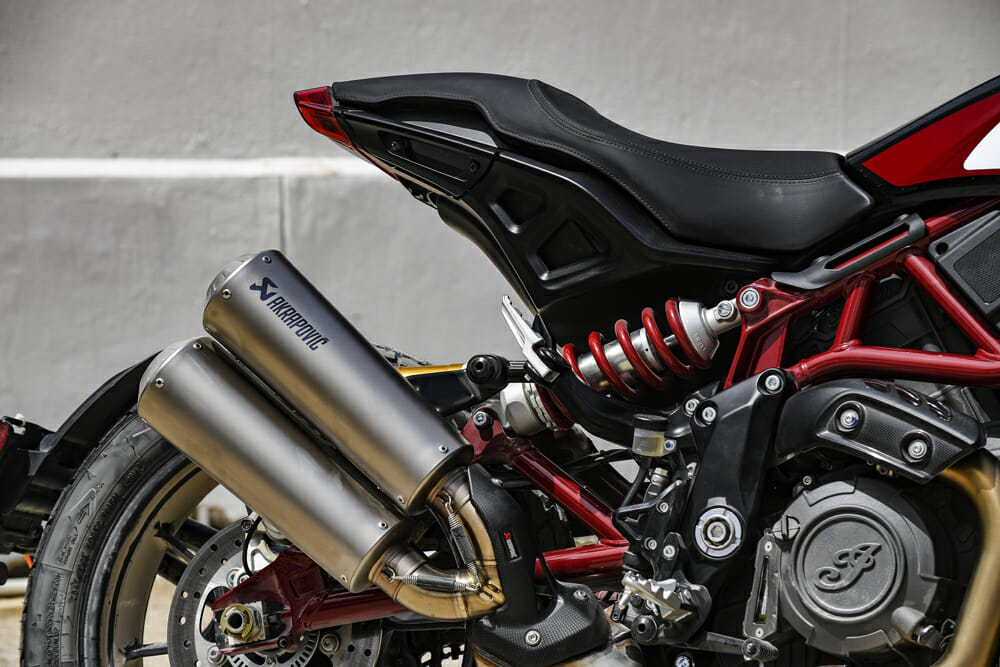 Akrapovic titanium mufflers on the FTR 1200 S Racer Replica look and sound the business.
Akrapovic titanium mufflers on the FTR 1200 S Racer Replica look and sound the business.
Getting the go to the ground is a new six-speed transmission and slipper clutch, although Indian has chosen not to grace either the base or 1200 S with a quickshifter.
Chassis-wise, both machines utilize tubular steel trellis design and an aluminum subframe, with the rear suspension slanted at 45 and attached directly to the swingarm. The FTR 1200 S frame gets the trademark Indian maroon red paint with black for the base model, although one of the most significant differences is the fully adjustable suspension for the S versus preload and rebound only on the rear for the base model.
Brakes are the same across both machines in the Brembo M4.32 monobloc front calipers biting down on 320mm discs, with the rear a 260mm disc and a single Brembo P34 two-piston caliper with ABS as standard on both models, but switchable only on the 1200 S.
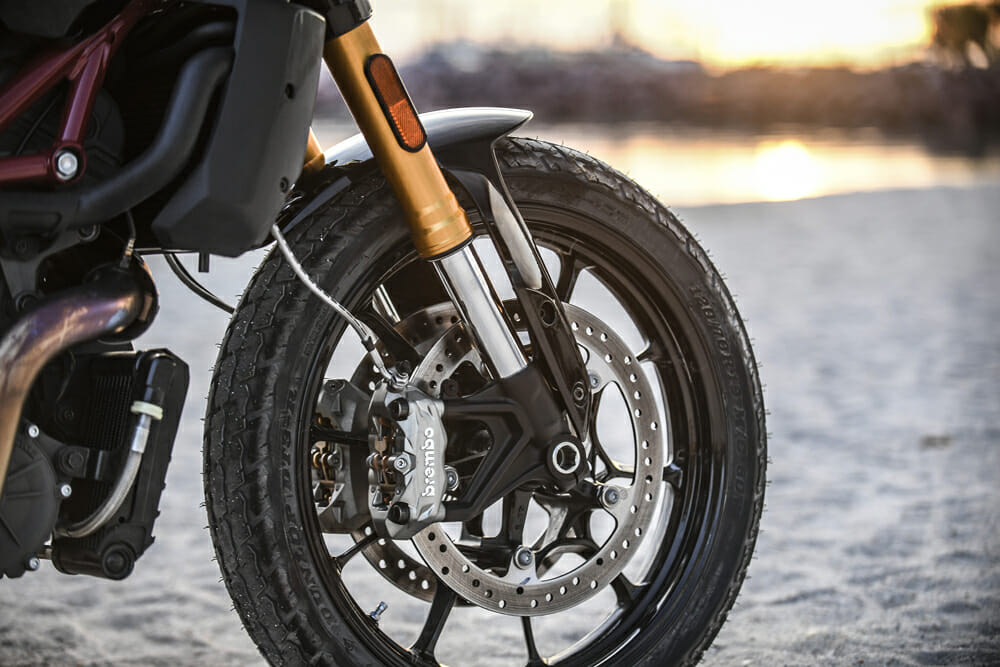 Brembo Monobloc brakes are standard fitment across both the FTR 1200 and FTR 1200 S.
Brembo Monobloc brakes are standard fitment across both the FTR 1200 and FTR 1200 S.
The show rolls on beautiful 19-inch front and 18-inch rear wheels with Dunlop developing a street version of their DT3 race tire in the DT3-R. The DT3 is a tire that’s won more races than even Dunlop cares to remember, and the street version looks very similar with tread blocks slightly closer together, a shallower treat depth and more silica to improve overall grip but especially wet weather performance.
Dry claimed weight is 488 lb for the base model and 489 lb dry for the S.
In the cockpit, there are more differences between the base and S models. Both bikes come with cruise control as standard, although the base model comes with an old-school style analog speedo with the revs in a little digital readout at the base. The S gets a beautiful 4.3-inch Ride Command touch screen unit similar to the ones found on the Chieftain line-up. Within the screen, can get two different styles of read out, and it’s extremely easy to change not just the ride mode you’re in but also switch ABS and traction control off. ABS and TC are not switchable on the base model, even though both bikes run a Bosch six-axis IMU for the lean angle sensitive traction control, ABS and wheelie control, so if you wanna do wheelies and skids, you need to buy the 1200 S.
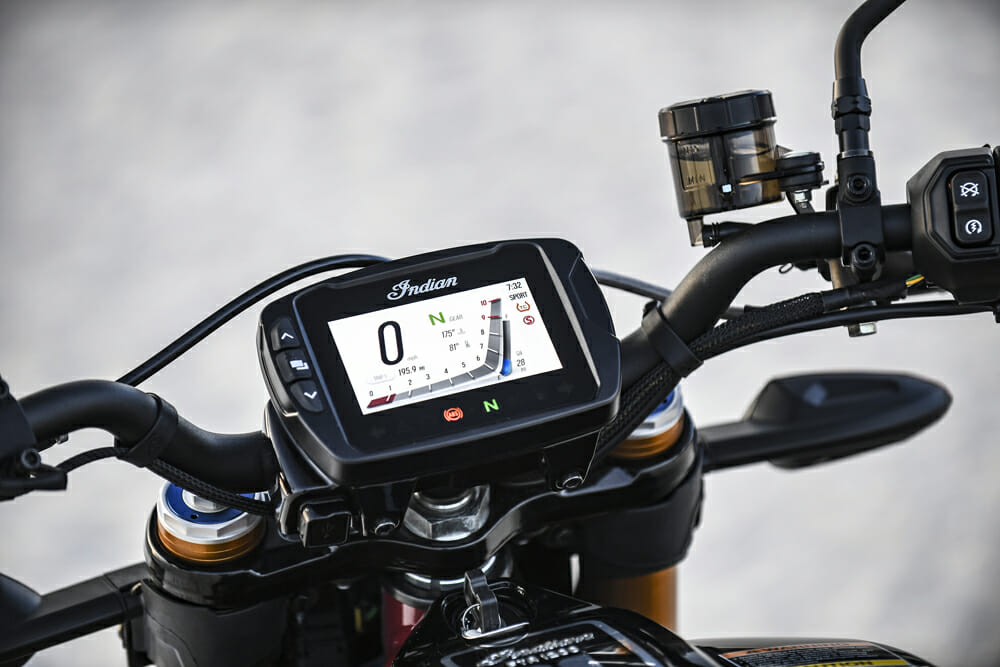 The touchscreen dash is an excellent feature on the 1200 S.
The touchscreen dash is an excellent feature on the 1200 S.
Getting it done in Mexico – 2019 Indian FTR 1200 Review
Mexico riding can be a little sketchy at times, so that made the 45 miles of sand we covered on a bike designed 95 percent for the street all the more intense. It also showed that this is a motorcycle, a bit like an adventure bike, that you can take almost anywhere.
Riding a big bike on sand is a challenge, to say the least, but once I got to understand the language of the FTR, it really wasn’t that bad. Switch the ABS and TC off, get up off the seat, put the 1203cc motor in fifth gear, keep the revs down and just let the bike pull you over the sand. With 5.9 inches of front and rear suspension travel, you’d have to be pretty harsh indeed to bottom the thing out, and with a genuinely surprising level of grip on offer from the Dunlop DT3-R tires, riding on the sand was an entirely enjoyable—if intense—experience.
The sand riding also highlighted how smooth and flexible the FTR motor is, especially when you keep the revs down. Putting the ECU in Rain mode for 94 horsepower was the go, with a smooth and predictable throttle response on offer. It made me think this engine would be great in an adventure bike.
But riding an FTR on sand will probably happen for around 1.8 percent of all FTR’s sold. The real riding will be done on the street, and after our little sand soiree, the remainder of the test was spent riding the coast roads between La Paz and Cabo San Lucas.
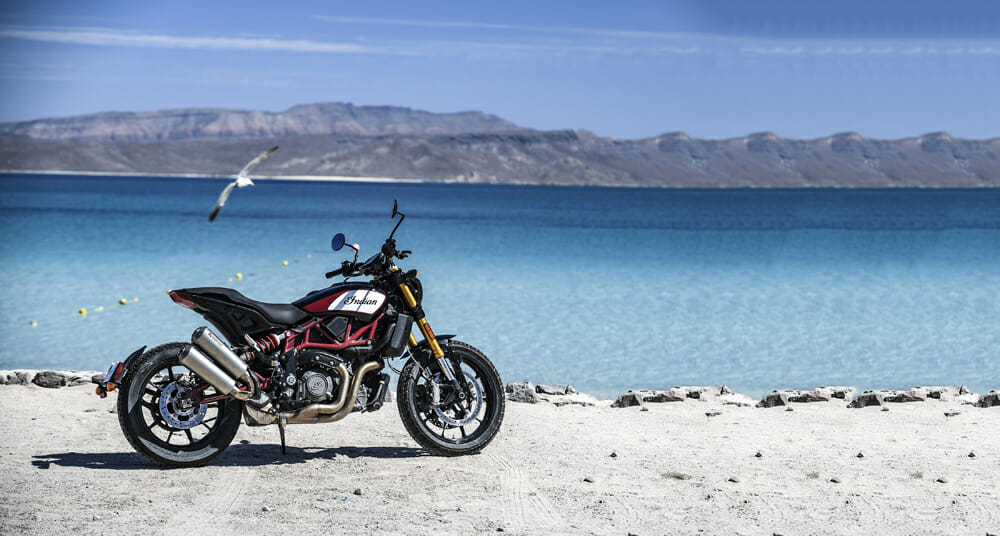 Love at first beach. The slippery sands of Cabo San Lucas and the Indian are well suited to each other.
Love at first beach. The slippery sands of Cabo San Lucas and the Indian are well suited to each other.
In creating the FTR 1200, Indian has delivered a motorcycle that is truly one of a kind but one that can handle a variety of situations. Just as it was surprisingly comfortable in the sand roads along the beach, the FTR will happily play at giving a sport bike a run for its money or be comfortable a touring bike.
The riding position is aggressive—you’re leaned towards the front wheel, and with the bend and width of the bars you’re in that flat tracker pose right away—but it’s very comfortable for even the two 10-hour days we put down in Mexico.
Getting its sport bike on is where the true nature of the FTR lies. Regardless of the fact the tires are replicated from dirt riding, the FTR loves to be thrashed on the street. In Standard or Sport mode, charging through the gears reveals one major personality trait. As the motor was nice and docile in the sand at low revs, when hard on the gas between 5-7000 rpm there’s a definite kick in the power, almost a bit reminiscent of a two-stroke. The motor truly comes alive as it surges past 6000 rpm, which can make holding a wheelie a touch difficult (if you’re that way inclined). The motor continues to build power through to about 7500 rpm, before gradually running out of steam as it sails past 8000 rpm to a speed limited 124 mph.
I would genuinely have liked to see Indian fit a quickshifter to the 1200 S model, as the price charged warrants one, in my option. The gearshift itself is pretty smooth, all things considered, but not fitting a quickshifter is an oversight.
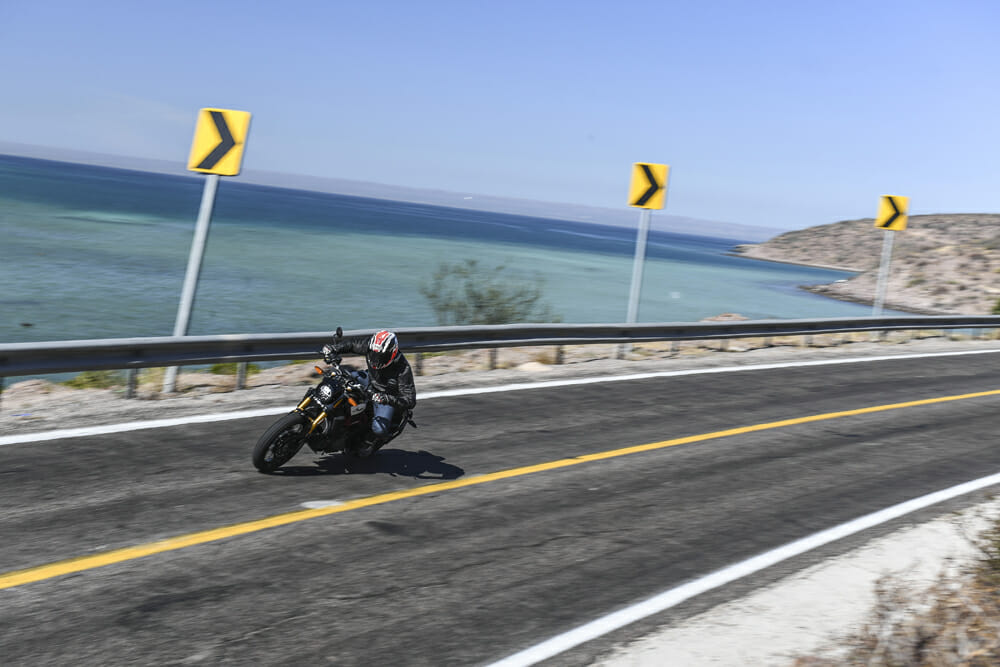 You can hustle the FTR along with serious pace on the street despite the dirt track-derived tires.
You can hustle the FTR along with serious pace on the street despite the dirt track-derived tires.
There’s a definite difference in feel between the suspension on both models. Although the front springs are reportedly the same across the 1200 and 1200 S, the base model has a plusher feel than the stiffer 1200 S. The 1200 S is much more angled at, err, more spirited riding compared to the base model, with the valving front and rear firmer than the base model. The offshoot of this is you can tune the 1200 S’s suspension with full adjustment front and rear, whereas with the base model, you have only preload and rebound damping adjustment. The base model makes for a more comfortable, cruisy ride experience, but begins to show its price point as the speed increases and the riding becomes more aggressive.
As mentioned earlier, I was surprised to see how much grip was on offer from the Dunlop DT3-R. Loading the front up under brakes and pushing, the DT3-R doesn’t have 17-inch sport bike levels of grip but still has enough on offer for ride hard—certainly more than a tire derived from a dirt track race hoop has any right to on the tar. Not only that, the tire has a supreme visual effect on the FTR’s aesthetics, separating this bike from anything else on the market.
And that’s part of the appeal of the FTR. This motorcycle is as much a fashion and a visual statement as it is a performance one. It can handle pretty serious riding, as evidenced by blasts along the coast and sand riding in the same day, but the styling is never far from the rider’s mind with the FTR.
As the only street tracker available from a modern motorcycle manufacturer, the FTR is thus in a league of its own. Is this the motorcycle Indian’s rivals from Milwaukee should have built? Most definitely, especially when you consider how long H-D were racing unchallenged in American Flat Track.
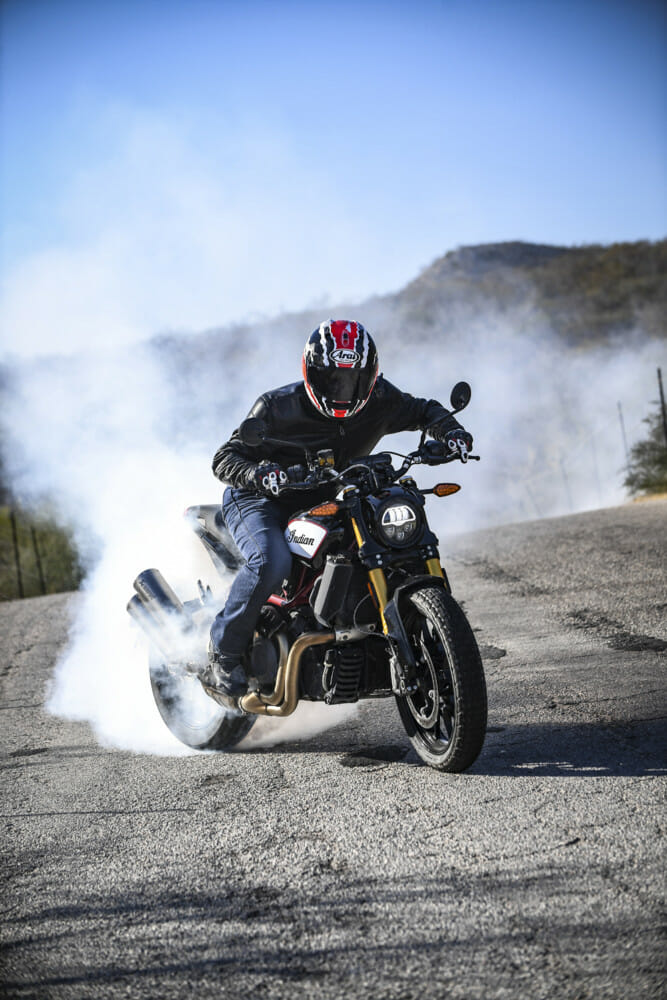 Smoke ’em if ya got ’em!
Smoke ’em if ya got ’em!
That’s an argument for another day. The FTR 1200 and FTR 1200 S will be making in sales enormous impact not only here but across the globe, because as flat track racing continues its seemingly exponential growth rate and riders want one in their garage, there’s only one option.
Luckily it’s a good one from Indian Motorcycle.
Check out our 2019 Indian FTR 1200 Video Review
2019 Indian FTR 1200 Designer Rich Christoph Speaks
The Indian FTR 1200 is the work of former Harley-Davidson and Buell designer Rich Christoph, a man who grew up on a diet of Italian sport bikes but has now found a home with Indian. He’s a man intensely passionate about mechanical design, and here he guides you through some of the through processes that came about with the FTR.
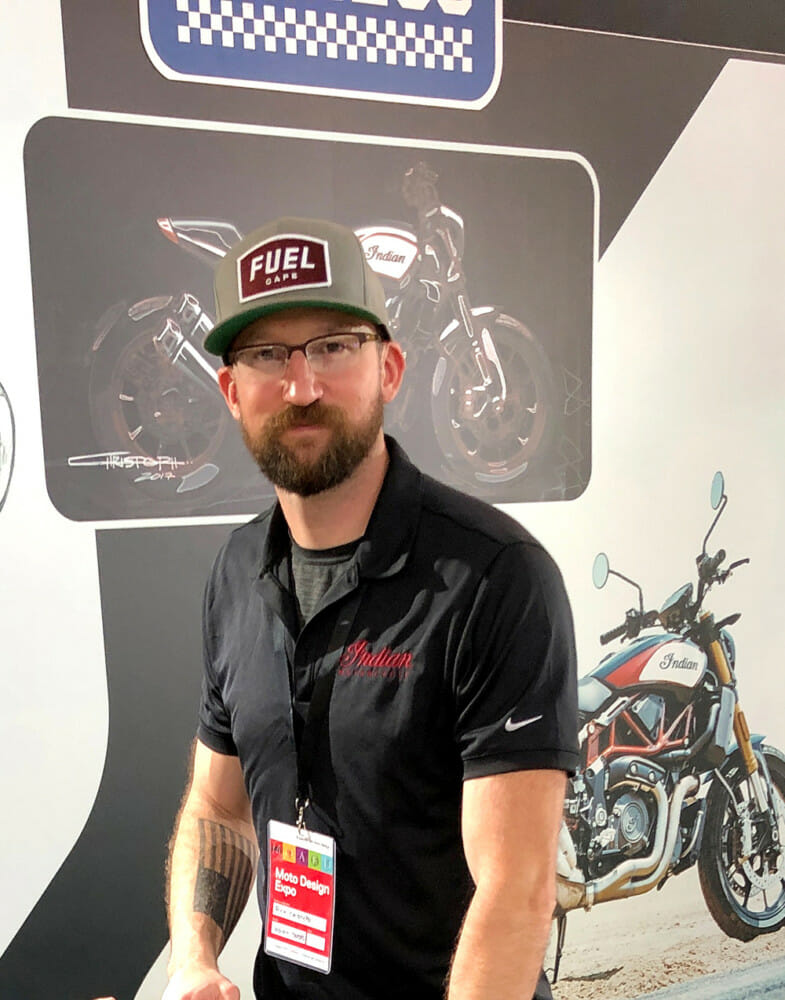
“You’re trying to capture the motion in the highlights and the energy of the race bike,” Christoph says. “You’re up and over the handlebars, keeping your weight forward. You work on continuing the seamless line up into the tank with the riding position. The 1200 is a little bit wider, so it kind of pushes the frame out and subsequently you have to work the surfaces in so you can get that commanding riding position and be able to slide forward. Then obviously, you need a passenger, but that helps you visually shorten up that rider cockpit and make it a much more appropriate proportion for the street.
“What we wanted was a machine that was fun. It was spirited. It looked aggressive. It looked beautiful. It looked purpose-built. It was reminiscent of the 750, and it captured the essence of that motorcycle, but it allows you to ride it all day and have a lot of fun. We focused a lot on fun, a lot on kind of losing yourself in the moment and forgetting about being critical and just enjoying the ride.
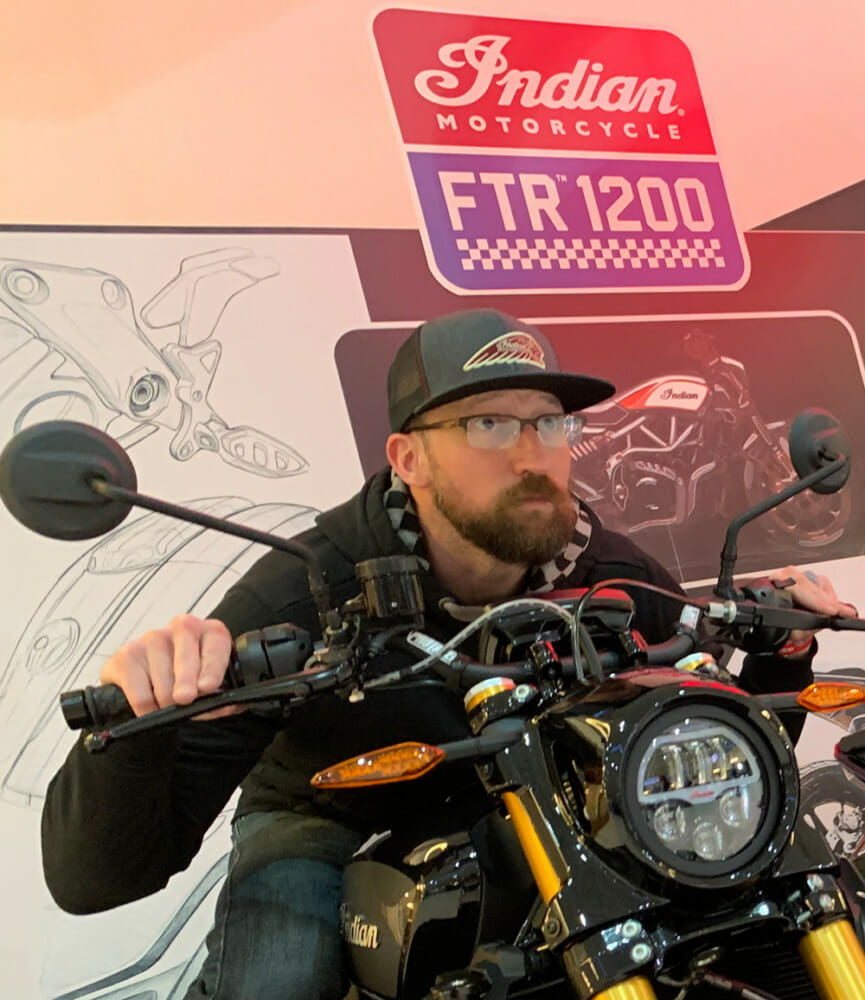 Christoph’s love of design is infectious, and he takes great pride in his creation of the FTR 1200.
Christoph’s love of design is infectious, and he takes great pride in his creation of the FTR 1200.
“I got a chance to work with Eric Buell briefly in one of my previous lives, and his mantra was always “design the air out of the bike.” That means tight. Every part inside for packaging is tight, tight, tight, sitting on top of the next part. That was the focus here, too. You want to keep this bike a tight, small, compact, and efficient design. Much like the FTR750, with the 1200, we had to intelligently position where the airbox was, where the fuel was, where the battery was, and then wrap that body and all that muscle with skin, all that musculature with skin and you form this beautiful silhouette. It’s very balanced. It’s very sleek and sensual.
“I was always inspired by the MV Agusta F4, Ducati 916 and the 996. I grew up on a Suzuki TL1000S. Aprilia was very nice, but there was something a little bit more harsh about it in the way it was executed. So I took that kind of application of celebrating engineering. How do you make the engineering sexy, passionate? That’s where the real challenge comes in. But if you just ignore engineering, then it just looks like a form that was done for no reason. So it really takes a close relationship between engineering and design to design in all of those details but make them look sculpted, make them look passionate. To make it look like bone and muscle and tendon. That’s a very muscular way and a very strong and performing way to execute kind of this foreign language and all the details.”CN
Customizing Your 2019 Indian FTR 1200
Indian may have created two mechanical platforms in the FTR 1200 and FTR 1200 S, but they’ve also added four different cosmetic packages you can choose from to turn your street tracker into a sportbike, or even a tourer.
Importantly, you are not limited to just the parts in your chosen package. You can swap out parts from any package and make them work with the FTR, giving you a very large platform to modify your bike from.
2019 Indian FTR 1200 Tracker Package
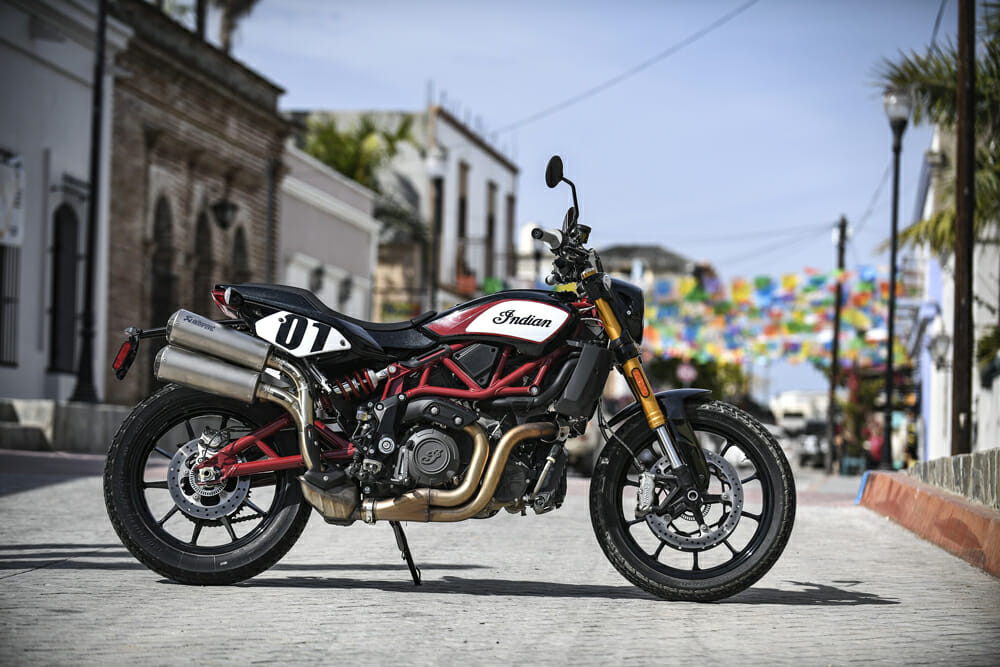
To make your street tracker more, err, street tracker-ee, you can pick up the Tracker package that includes:
- Akrapovic high-mount slip-on exhaust
- Tracker-style seat
- Side number plates
- High-mount license plate
- Tracker seat base cowl
- Rally footpegs by ProTaper
- ProTaper handlebar grips
- Clear turn signals
2019 Indian FTR 1200 Rally Package
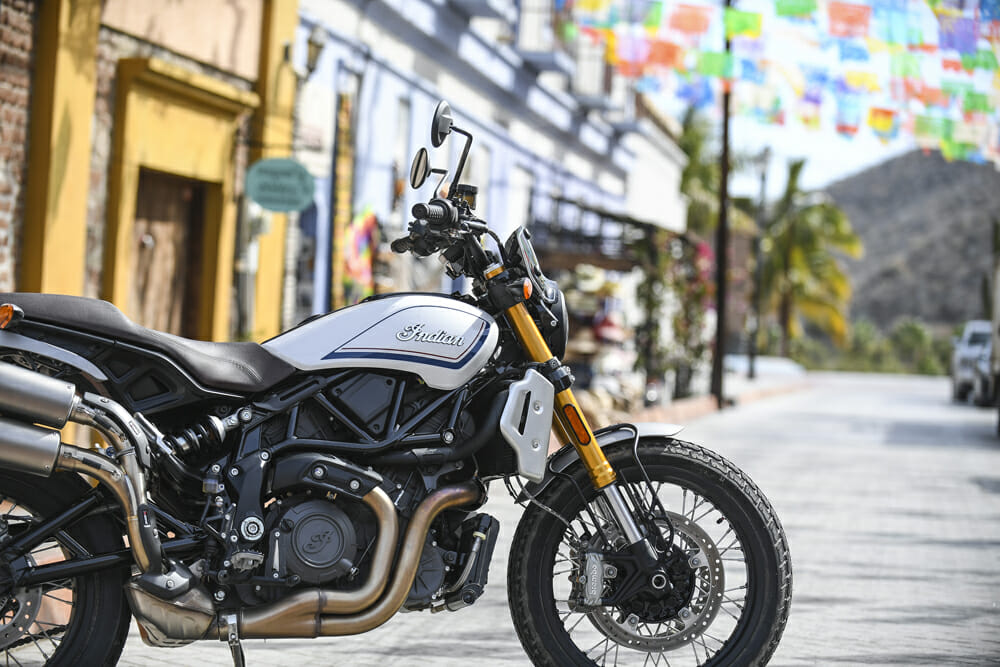
The Rally pack looks pretty cool and takes the FTR in a different direction to the street tracker roots. Included in the Rally pack are the following:
- Akrapovic high mount slip-on exhaust with passenger peg mount
- Aluminum spoke wheel set
- Windshield
- Front and rear mudguards
- Aviator seat
- Rally footpegs by ProTaper
- High-mount license plate
- Aluminum radiator guards
- Different tank covers
- ProTaper rally handlebar
2019 Indian FTR 1200 Sport Package
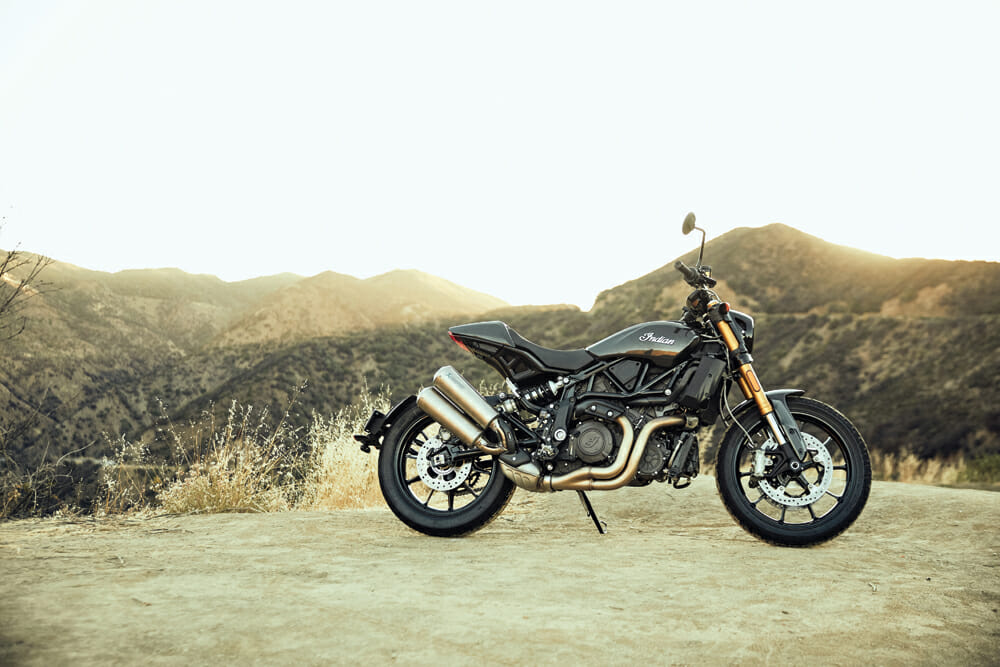
The Sport collection is firmly angled for the street and features:
- Low-mount Akrapovic muffler
- Carbon-fiber tank covers
- Carbon-fiber seat cowl
- Carbon-fiber front guard
2019 Indian FTR 1200 Tour Package
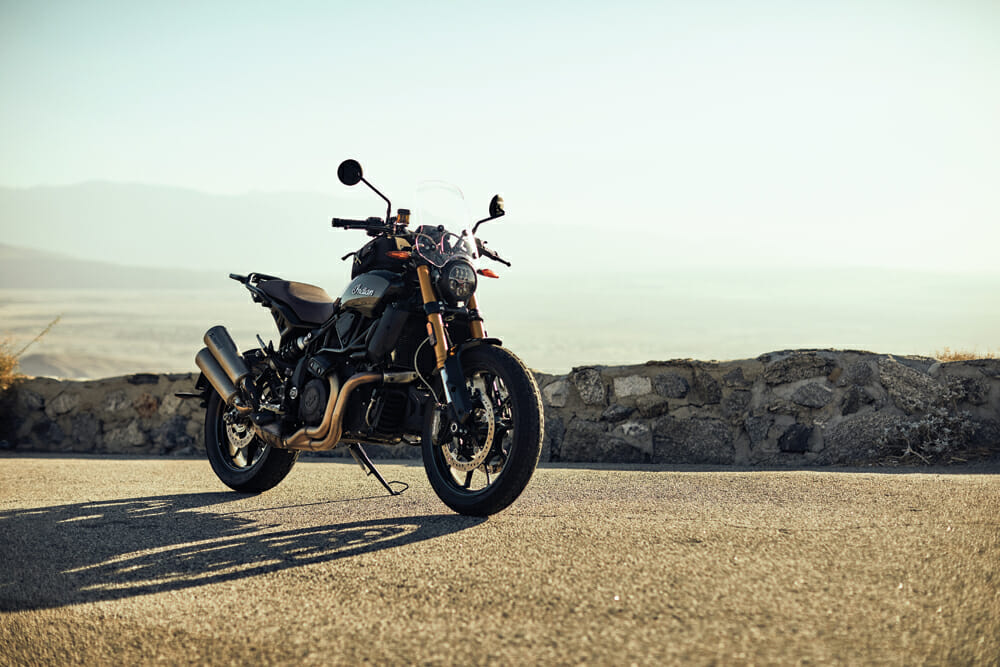
The Tour collection is quite expansive, turning the FTR 1200 into a full-time mile muncher. The Tour pack includes the following:
- Luggage racks, top, and side bags
- Mid-height windshield
- Tank bag
- Low-mount Akrapovic muffler
- Fork guards
- Grab handles
- Tank covers
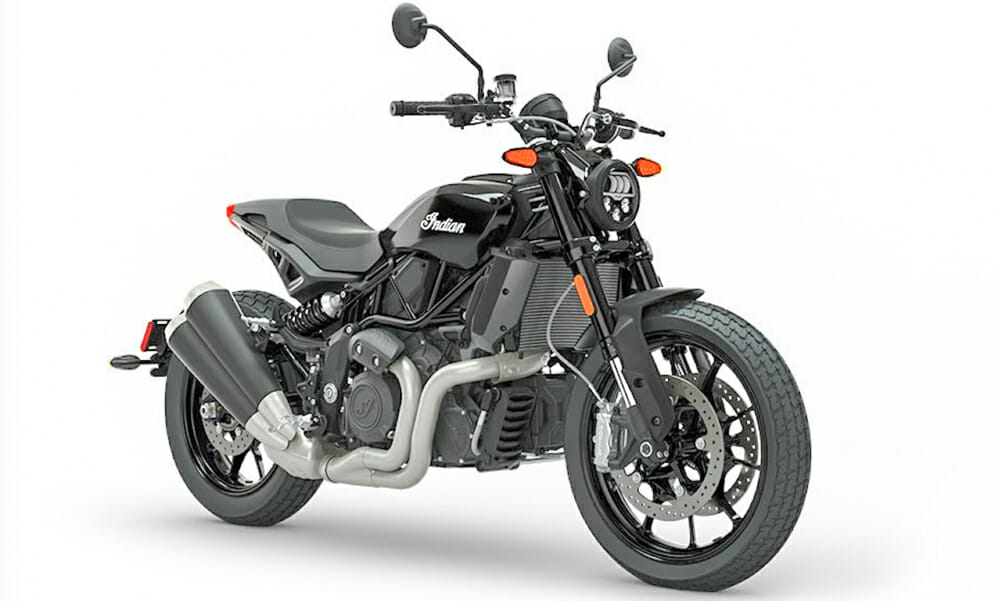
2019 Indian FTR 1200/1200 S Specifications
| MSRP: |
$13,499 / $15,499 |
| Engine: |
DOHC, 4-valve, 65 V-twin |
| Displacement: |
1203cc |
| Bore x stroke: |
102 x 73.6mm |
| Compression ratio: |
12.5:1 |
| Fuel system: |
EFI |
| Power: |
123 hp at 8250 rpm |
| Torque: |
87 lb-ft at 6000 rpm |
| Exhaust: |
2-1 |
| Clutch: |
Wet multi-plate |
| Transmission: |
6 speed |
| Chassis: |
Tubular steel trellis |
| Front suspension: |
43mm fork, non-adjustable / 43mm full adjustable fork |
| Rear suspension: |
Slanted monoshock, adjustable preload and rebound damping/fully adjustable shock |
| Front wheel travel: |
5.9 in. |
| Rear wheel travel: |
5.7 in. |
| Front brake: |
Dual 320mm discs, dual 4-piston Monobloc calipers, Bosch Cornering ABS |
| Rear brake: |
265mm disc, 2-piston caliper with Bosch Cornering ABS |
| Front tire: |
Dunlop DT3-R, 120/70 R19 |
| Rear tire: |
Dunlop DT3-R 150/80 R18 |
| Wheelbase: |
60 in. |
| Seat height: |
33.1 in. |
| Fuel capacity: |
3.4 gal. |
| Electronics: |
Bosch six-axis IMU, traction control, ABS, wheelie control, non-adjustable / switchable traction control, ABS. |
| Dry weight (claimed): |
488 lbs. / 489 lbs. |